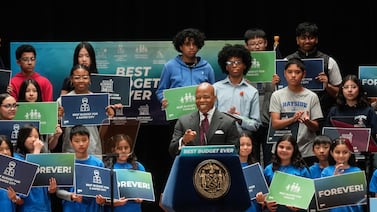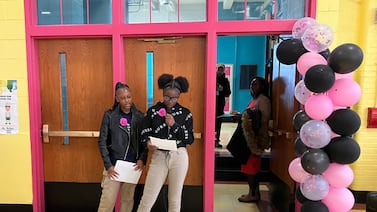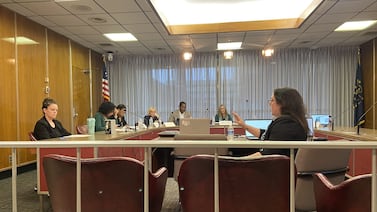The nation’s top public health officials continued to hint Wednesday that changes to guidance on physical distancing in schools could be coming soon — a shift that could clear the way for more students to return to school buildings five days a week.
Changes to the Centers for Disease Control and Prevention’s recommendations may be on the way, CDC Director Rochelle Walensky said at a Congressional hearing Wednesday.
“Science evolves,” she said. “We are looking to update our guidance.”
She did not make a definitive commitment, though, noting that the CDC is looking at emerging data from different sources. But her comments echoed others made by Dr. Anthony Fauci on CNN this weekend. “The CDC is very well aware that data are accumulating making it look more like three feet are okay under certain circumstances,” he said.
Pressure on the CDC has come from advocates and some experts who argue that any benefit that six-foot requirement is far outweighed by the resulting downsides of remote instruction for students. Pressure is already coming from the other side, too, with a prominent teachers union leader warning against revamping the guidance.
The CDC current guidance dates to February. The agency’s highly anticipated recommendations said that in areas where COVID spread is substantial, schools should require staff and students to remain six feet apart, and they should generally allow only a portion of students to come in each day. Even when community spread is low or moderate, the CDC said, schools should strive to maintain six feet of distance “to the greatest extent possible.”
The scientific brief the CDC released alongside its February recommendations did not provide a specific basis for privileging distancing of six feet over three feet.
That approach to physical distancing quickly drew scrutiny. When that guidance was released, the vast majority of the country was seeing substantial or high rates of community spread. Some who had been pushing for more in-person instruction quickly identified it as a roadblock.
Walensky acknowledged as much Wednesday. “As soon as our guidance came out, it became very clear that six feet was among the things that was keeping schools closed,” she said.
Schools are not required to follow the CDC’s guidance, and in states including Colorado, three-foot distancing has already been the norm for young students. It’s unclear exactly what share of U.S. schools are strictly following the six-foot rule, but the latest estimates suggest that about half of American schools are offering in-person instruction five days a week.
“Districts like Stamford, CT, and Nanuet NY are referencing the fact they will not be at 6 feet distancing when they shift to traditional, and we are seeing more of that every day,” Dennis Roche of Burbio, an organization that has tracked school reopening trends, said in an email.
The debate on the issue shifted with the release of a Massachusetts study, which found evidence that three feet could be enough. The paper compared school districts that had worked to keep students three feet apart and those that stuck to six feet. Accounting for rates of community spread, there was no clear difference in COVID cases among students or school staff, although some experts have raised concerns about whether firm conclusions could be drawn from the results.
Walensky cited the paper but emphasized that there is still limited data on the issue and that the CDC is evaluating new information as it comes in. “There are several other emerging studies that I am aware of,” she said. “We have only one published study to date.”
Another recent paper found that COVID rates were higher among families whose children attended schools in person than among families whose children learned virtually. But whether a child attended school part-time versus full-time didn’t make much of a difference if other precautions, like mask-wearing and frequent testing, were in place at the school.
The World Health Organization advises distancing of “at least” one meter, or 3.3 feet.
Other research is more equivocal, though all of the research in this area is fraught with complications.
One review of studies looking at COVID spread in different settings and different countries found that three feet of distancing substantially reduced spread, but that six feet could be even more effective. The report concluded that three feet distancing is absolutely necessary, and that six feet should be implemented “if feasible.”
A study of Michigan and Wisconsin found some evidence that when a larger share of students returned to school buildings — making physical distancing more challenging — COVID spread in the community increased if community spread was already moderate or high.
An across-the-board benchmark for distancing may be the wrong way to think about this anyway, according to some experts. For instance, in a well-ventilated setting where everyone is wearing masks and no one is shouting, less distance may be necessary than in a poorly ventilated space where people are spending long periods.
Walensky says the CDC will follow the science — but the issue is a fraught one politically.
That was underscored by the comments from AFT’s Weingarten, a Biden ally. “The problem is, it is a debate about convenience, not a debate about safety,” she told the New York Times.
To some, this misses the point. If holding to six-foot distancing means more students must remain at home, any potential reduction in COVID spread must be weighed against the downsides of remote instruction. Students have fallen behind academically: test scores are down while course failure rates are up. Educators and parents are concerned about students experiencing social isolation and mental health challenges. Parents whose children are in remote or hybrid settings report are less satisfied with the quality of their child’s education.
“Our kids are in crisis,” said Rep. Cathy McMorris Rodgers, a Washington Republican who questioned Walensky on Wednesday. “Our schools need to be opened. I don’t think we need to wait for more studies.”
Last week, Detroit Public Schools Superintendent Nikolai Vitti said he would welcome a change in the CDC’s social distancing guidelines.
“I think it is appropriate to move to three feet based on what I already see happening in schools,” he said. Even so, he said, it might take time to convince his community of the safety of relaxing the district’s current approach.
Kalyn Belsha contributed reporting.







